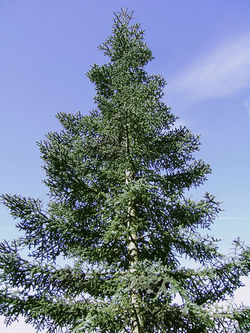
full species name
| Noble fir |
|---|
 |
| Scientific Classification |
| Abies procera |
full species name |
| Noble Fir Cone |
The Noble Fir is a species of fir known by the scientific name Abies procera. It is more commonly known as the tree which is often used as a Christmas Tree by families all across the United States. The Noble Fir is a large Evergreen Tree that can grow up to 130–230 feet tall and a 6.5 foot trunk diameter. The bark on young trees is smooth and gray with resin blisters, becoming red-brown, rough and fissured on old trees. The leaves are needle-like, they can be 1–3.5 cm long, and are dark on the top and light on the bottom, and have a blunt to notched tip. The cones on Noble Firs point straight up unlike most other trees. Noble Firs are native to the Pacific Northwest region of the U.S. Also known as red fir or white fir, it is an impressive true fir limited to the Cascade Range and Coast Ranges of the Pacific Northwest.
Noble Firs attain the largest dimensions of any of the true fir species. The Noble Firs wood has always been valued over that of other true firs because of its greater strength. Loggers called it larch to avoid the prejudice against the wood of true fir; the two Larch Mountains opposite one another across the Columbia River near Portland, Oregon, were named for the Noble Fir that grows on their summits. Because of its high strength-to-weight ratio, it has been used for specialty products, such as stock for ladder rails and in the construction of airplanes.
The cones on the Noble Fir point straight up unlike most conifers were they point down. The leaves on Noble Firs are needle like, unlike many other trees with needles. The needles are darker on the top, and lighter on the bottom. The Noble Fir grows best in the full sun or partial shade. It grows best in deep, moist, cool, well-drained, acidic soil. Though it can still grow in thin, rocky soils with good moisture. The Noble Fir has bark that is gray-brown and smooth, becoming dark gray, brown or reddish-brown and furrowed into irregular, long, scaly plates. Its bark is thick compared to other trees.
The Noble Fir can grow from 2 feet to 3 feet per year. Their branches can be as wide as 30 feet. And their trunks can grow up 5 feet wide. The Noble Fir is a large Evergreen Tree that can grow from 130 feet tall to 230 feet tall. Occasionally they can even grow up to 295 feet tall. The bark on young Noble Fir trees is smooth and gray with resin blisters, becoming red-brown, rough and fissured on old trees. They will be some of the very first trees to start growing after a forest fire.
Most Noble Firs seeds germinate in the first year after dispersal. They remain viable for only one season in the forest floor. Noble Fir seeds germinate freely, and seedlings grow well in the open. Initial development of seedlings is typically slow. Noble fir is not known to reproduce vegetatively. Noble Firs can reaches ages of 200 years to 250 year, though they can occasionally reach 300 years.
The Noble Fir is often a pioneer tree on middle to upper elevation sites, establishing itself quickly after a disturbance. It can grow quickly and can even surpass Douglas Fir. They are located in moist regions were there is lots of rain year round. Noble Firs are native to the Pacific Northwest region of the U.S. Also known as red fir or white fir, it is an impressive true fir limited to the Cascade Range and Coast Ranges of the Pacific Northwest.
In 1979, the Noble Fir constituted about 12 percent of the Christmas tree production in the Pacific Northwest and was priced 35 to 40 percent higher than Douglas-Firs. As of 2009, it was the third most popular Christmas tree species in the U.S. Noble Fir greenery is also in considerable demand and can provide high financial returns in young stands. Noble Firs are easily recognized by upward curving needles that grow on opposite sides of a branch. Ornaments hang nicely from their open, symmetrically spaced branches. The Noble Fir makes a very good family Christmas tree because they are big, they have strong branches for holding heavy ornaments, they look very grand when covered in lights and ornaments, and there branches are well spaces out for you to hang ornaments.
Noble Mountain Tree Farm
http://www.arborday.org/trees/treeguide/TreeDetail.cfm?ItemID=1106 http://nativeplantspnw.com/noble-fir-abies-procera/ http://www.realchristmastrees.org/dnn/education/treevarieties/noblefir.aspx
|
||||||||||||||||||||